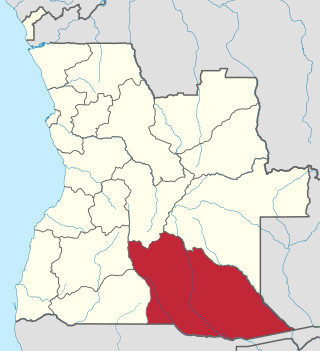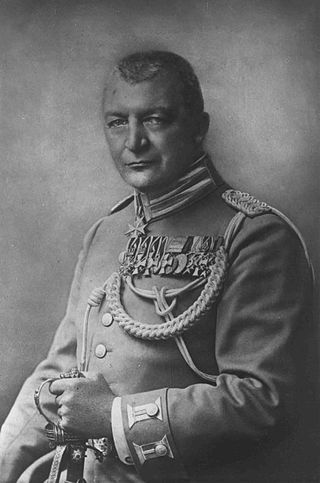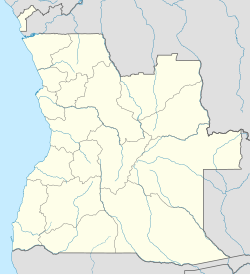
The South West Africa campaign was the conquest and occupation of German South West Africa by forces from the Union of South Africa acting on behalf of the British imperial government at the beginning of the First World War.

Cuando Cubango is a province of Angola and it has an area of 199,049km2 and a population of 534,002 in 2014. Menongue is the capital of the province. The governor of the province is José Martins, who was appointed governor in November 2021.

Cunene is a province of Angola. It has an area of 87,342 km2 and a population of 990,087 in 2014.

The Cunene or Kunene is a river in Southern Africa. It flows from the Angola highlands southwards to the border with Namibia. It then flows in a westerly direction along the border until it reaches the Atlantic Ocean. It is one of the few perennial rivers in the region. It is about 1,050 kilometres (652 mi) long, with a drainage basin 106,560 square kilometres (41,143 sq mi) in area. Its mean annual discharge is 174 m3/s at its mouth. The Epupa Falls lie on the river. Olushandja Dam dams a tributary of the river, the Etaka, and helps to provide the Ruacana Power Station with water.
Ondjiva, formerly Vila Pereira d'Eça, is a town, with a population of 121,537 (2014), and a commune in the municipality of Cuanhama, province of Cunene, Angola. It is also the administrative capital of Cunene Province and is located at the extreme south of the country, about 42 kilometres (26 mi) from the border with Namibia. It was traditionally the seat of the Ovambo king of the Oukwanyama tribe. Ondjiva was greatly affected by the Angolan Civil War (1975-2002).

Outjo is a town of 6,000 inhabitants in the Kunene Region of Namibia. It is the district capital of Outjo Constituency. It is best known as the main gateway to Etosha National Park.

The African Theatre of the First World War comprises campaigns in North Africa instigated by the German and Ottoman empires, local rebellions against European colonial rule and Allied campaigns against the German colonies of Kamerun, Togoland, German South West Africa, and German East Africa. The campaigns were fought by German Schutztruppe, local resistance movements and forces of the British Empire, France, Italy, Belgium, and Portugal.

Erich Victor Carl August Franke was a German military officer and the last commander of the Schutztruppe in German South West Africa. Franke was born in Zuckmantel, Austrian Silesia. He was Bezirksamtmann in several German South West Africa locations, especially Ovamboland and Kaokoveld. He was stationed at Outjo from 1899 until 1910. He was involved in several campaigns against native tribes who resisted German colonial rule. In the early phases of the Herero Genocide of 1904, he was dubbed "Hero of Omaruru", because of his victory over numerically superior Herero forces at Omaruru. He also had successful campaigns against the Herero at Okahandja and Windhoek.

Calueque is a town next to a dam and pumping station of the same name on the Kunene River in the Kunene Province of southern Angola. The water project is linked to Ruacana, 20 km (12 mi) away in Namibia, where the Ruacana Power Station is. This dam is one of the last landmarks along the Kunene River, prior to the Kunene becoming a border feature between Angola and Namibia. A 300 km (190 mi) pipeline and canal extends across the border into Namibia, supplying towns as far away as Oshakati in Ovamboland with water. The dam was completed in 1976. However, due to the onset of the Angolan civil war following independence, the full master plan for the scheme was not realised by the South African and Portuguese governments.

Angola is located on the western Atlantic Coast of Southern Africa between Namibia and the Republic of the Congo. It also is bordered by the Democratic Republic of the Congo and Zambia to the east. The country consists of a sparsely watered and somewhat sterile coastal plain extending inland for a distance varying from 50 to 160 km. Slightly inland and parallel to the coast is a belt of hills and mountains and behind those a large plateau. The total land size is 1,246,700 km2 (481,400 sq mi). It has an Exclusive Economic Zone of 518,433 km2 (200,168 sq mi).
Nkurenkuru is a town on the south-western banks of the Kavango River. It is the capital of the Kavango West Region of northern Namibia, located 140 kilometres (87 mi) west of Rundu. It is also a former mission station of the Finnish Missionary Society.
Namacunde or Namakunde is a town and municipality in Cunene Province in Angola. The municipality had a population of 142,047 in 2014.

The German campaign in Angola took place before the official declaration of war between Germany and Portugal in March 1916. German and Portuguese troops clashed several times on the border between German South West Africa and Portuguese Angola. The Germans won most of these clashes and were able to occupy the Humbe region of southern Angola until Portuguese control was restored a few days before the British campaign out of South Africa defeated the Germans.
Lutheranism was first introduced to Angola in the late 1800s, when Finnish missionaries began working in northern Namibia and southern Angola. Following the Portuguese defeat of Mandume Ya Ndemufayo in 1917, the Lutheran church in Angola was repressed by the Roman Catholic Portuguese authorities. In 1956, Lutheranism was reestablished in Angola, and in 1991, the Evangelical Lutheran Church of Angola was organized as an independent church body. In 1997, a smaller group of conservative Lutheran missionaries helped to organize a second Angolan Lutheran church: the Confessional Lutheran Church in Angola.
Operation Excite/Hilti was a set of military operations by the South African Defence Force (SADF) during the Angolan Civil War and South African Border War.

Naulila was the scene of fighting between Portuguese Angola and German South West Africa during the early stages of World War I. On 19 October 1914, a German military column crossed the border and entered Angola without authorization from the Portuguese authorities. The column was intercepted by Portuguese forces and conducted to Fort Naulila. At Naulila, a dispute occurred between the Portuguese and the Germans which resulted in the death of three German officers.
The Maziua raid was an armed clash between German and Portuguese colonial troops in Mozambique on 24 August 1914 during World War I. Though the two countries were officially at peace, German soldiers carried out a cross-border raid into Portuguese Mozambique for unclear reasons, and destroyed the outpost of Maziua. The Portuguese soldiers killed in the raid were the first Portuguese casualties of World War I.

The Ovambo Uprising was an uprising against Portuguese colonial rule in World War I. It lasted from about 18 December 1914 to 6 February 1917 with the death of its leader, King Mandume yaNdemufayo, by South African forces in Namibia. The war pitted Portuguese troops, commanded by General António Júlio da Costa Pereira de Eça, against an Ovambo army, composed mainly of fighters from the Oukwanyama clan.
Francisco Xavier da Cunha Aragão was a Cavalry officer of the Portuguese Army who reached the rank of lieutenant colonel.












